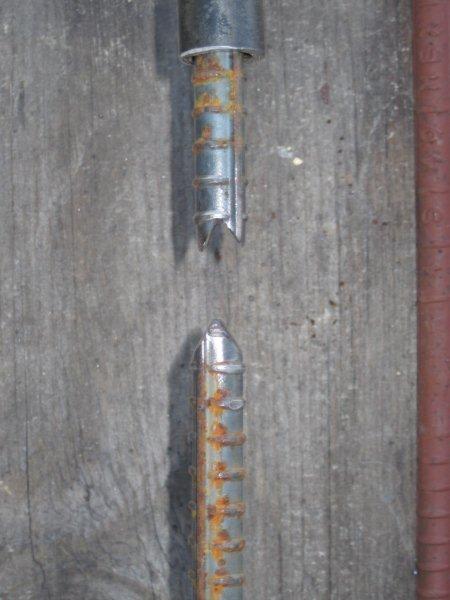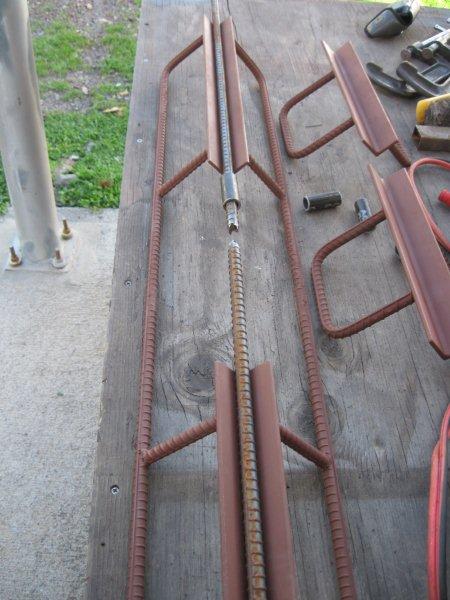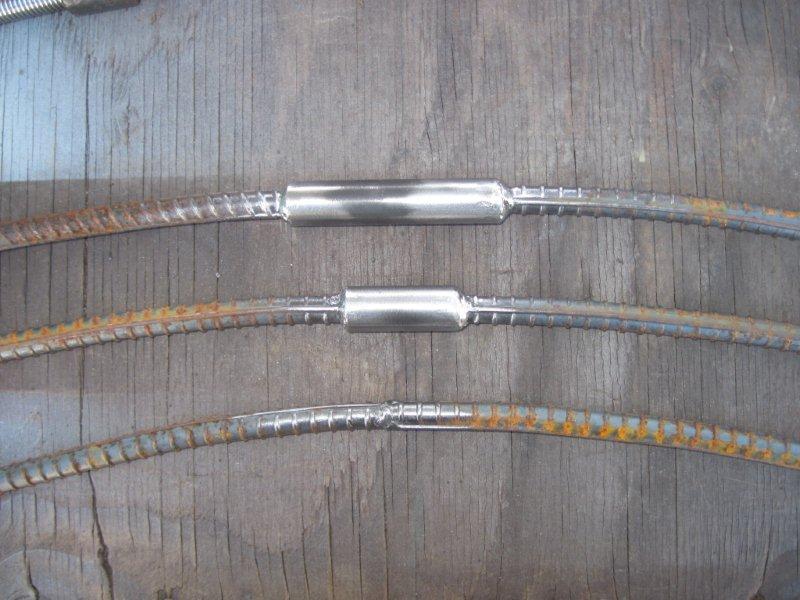Rebar Splicing
Last Updated: March 15, 2014
Photographs sequential, explanation at bottom...

The rebar is prepared with a 'dove tail' using a grinder. Cutting a 45 degree on one, with leaving the other flat makes for a better weld, but more problematic to align.

The prepared rebar is placed in the 'sled' which holds the two pieces in alignment, then clamped. The smaller 'sleds' to the side are for the full 20' lengths. The dove-tail is welded first, then a coupler is slid up over and welded.

Here are the pieces 'spliced', then bent in a mild arch (though exagerated over my actual needs). I did one without a coupler, one with a 2" coupler and one with a 4" coupler. The 4" coupler didn't provide any additional benefit over the 2" so it was ommitted in the full-strain testing

Here you see the results of the aggressive bending strain test. The non-coupled unit was bent in the axis of the weld and I expected the failure shown. No cracking of the welds (on the coupler) were seen.
Why / How am I Splicing Rebar?
The roof of the house is a tilted arch (and of course, the same ferrocement construct), so the lengths of the rebar needed for the roof arch sections varies from ~11' to over 30'.
Rather than order 30' (or longer) rebar, then have to figure out how to get it delivered to a remote rural area with narrow winding roads, I looked at how I could splice the links
from what I had on-hand.
If you do any research on what folks (like the ACI) have to say on rebar splicing, you will find that welding is not advised. The reason for this is the relatively high carbon content
of rebar since it is generally made from recycled steel. Welding higher carbon content steel causes brittleness, substantially weakening the bar (degrading its rated tensile strength).
Instead, it is recommended that you 'lap-splice' the bars, use engineered couplers (set-screw collars or similar) or use a weldable rebar (hard-to-find and expensive).
If welded, and you are under a building permit or in a commercial situation, you will be required to have every weld you do inspected.
My personal concern was that of rebar density within the concrete, as well as the tied laps slipping and punching through the concrete under stress.
Since I am using the spliced rebars in an arch, the actual stress is taken up though a composite matrix of the crossing rebar, the levels of mesh on either side, and the concrete plaster
that encases it all. Because of this, I was not concerned over a marked drop in tensile strength, only in the integrity of the spliced bar as I put it into place (and in the life of the
house itself).
I figured that if I could 'jacket' the rebar around the splice point, I could keep the stresses in-line (lap welding actually fails as a tear diagonally through the joint).
I first looked at the maximum OD of the rebar I was using, then referenced a standard steel products table and found that (for a #4, 1/2" bar), a 1/2" BPE (40-Std-40s) black pipe was perfect.
The OD is 0.804". the ID is 0.622, with a tensile strength of ~48Ksi. In addition, calculating the cross sectional area of such a pipe showed it at ~0.25in2, whereas the rebar is 0.198 in2.
This told me that if I could transfer the stresses to a coupler made of such a pipe section, I could meet my needs easily.
I decided that a 'sled' like construct would be needed to pull up the 2 pieces of rebar to be spliced. This would give me a way to clamp it firmly, prepare the rebar, then weld it.
I also decided that for ease of handling, I would weld the rebar together, then slip on the coupler and weld that. A butt splice risked torsional shear so I used the arrow notch dove tail as shown
-- easy and quick to do. If you note the stress test photo, you will see this weld has its downside -- specifically, it is difficult, if not impossible to fuse the center material.
But the use of the coupler bypasses the stresses around this joint; the rebar joint weld is really just to make it easier to handle while doing the actual splicing with the coupler.
I experimented with 2", 4" and 6" lengths of couplers, but ended up settling on 2" since this minimized congestion and the impact on constant radius arcs the resultant rebar might be
subjected to (like my arched roof).
For welding, I used a Lincoln MIG welder, set to 'C' and 3-1/2". I used NR-211 MP flux cored wire which has a tensile strength of ~86Ksi.
Note that what ever method you use to splice your rebar, make sure to offset (randomize the position of) the splices during the construction so any weaknesses are not in line (which could potentially lead to combined and catostrophic failure).